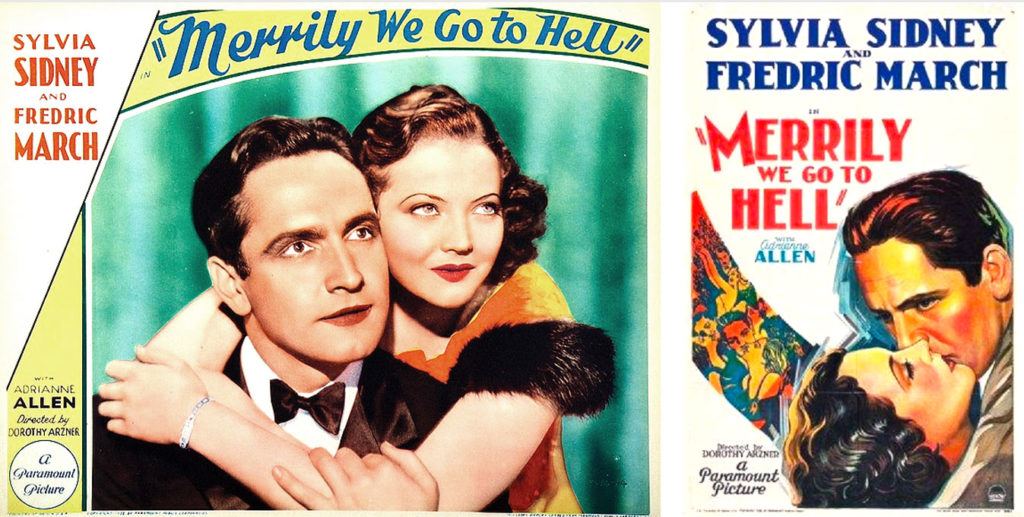I’m very interested in how music was and wasn’t used in sound films made 1929-36. The TCM Classic Film Festival’s screening of Merrily We Go To Hell that I attended provided a fascinating example of a sort of scoring that was done in the early ’30s without the use of a composer.
There is an unusual phenomenon in film scoring that happened once sound came in, in that dedicated underscoring almost completely disappears from movies. There are exceptions, of course, like Max Steiner’s work at RKO, but on the whole most films from this time period have no music at all, or include music as — get that dictionary ready — diegetic sound.

Dracula (1931) has no music at all, except for a bit of Swan Lake during the opening titles. And Mad Love (1936), also shown at the TCMFF, only has one brief moment of underscore. I’ve had a bit of success doing live theatre organ underscore for Dracula, which you can hear about on my podcast here or can experience this coming October at the Cinema Arts Centre.
There is an excellent book on the subject called After the Silents, by Michael Slowik. Slowik researched through documentation he could on the use of underscore from the time, and watched and studied the musical soundscapes of 250 or so films from this time period. I highly recommend the book. It will answer a lot of questions I had about why music was and wasn’t used in, and how it was used when it was.
Merrily We Go To Hell is an interesting hybrid, in that there is enough music in the film to make it feel like it did have a score. All the music, however, is music heard over a radio or which we understand to be performed off-camera in a nightclub or in a church.
The film’s opening title music is a medley of “How Dry I Am”, “Coming Through the Rye”, and one other tune I didn’t pick up on but which I assume also has a title related to alcohol consumption. There is quite a bit of music heard over the radio but which does not function as underscore. But there are also uses of radio or nightclub music that do serve to hint something dramatically to us.
Frederick March’s character drinks quite a lot throughout the film, right from the start actually. It’s the central point of the film’s plot. There is a point in his relationship with Silvia Sydney’s character when his partying and drinking really goes into overdrive, and the music we hear is more bluesy and jazz/swing than the other music we’ve heard. We hear it first when March and some other pals go to a Harlem nightclub. We hear music of the same genre again in a scene following of a drunken party in an apartment, the music now heard over a radio or phonograph.
One other unusual use I noticed, and this was something only organists (like me) would notice or would have picked up on in 1932, is during the scene in which March and Sydney are married. During the processional, we hear a church pipe organ playing “The Wedding March”, and at nearly full volume.
During their taking the marriage vows, however, we hear the song “I Love You Truly”. What’s interesting to me about this usage is that it’s played on a theatre organ. I noticed the organ registration includes a couple Tibia ranks, and it’s played softly, mixed under the dialog. Even if you don’t recognize the tune, the use of it and the way it’s performed and mixed makes it work like underscore.

Would it be fair to say that in the early years of talkies, the movie makers were trying to emulate the live theater experience and therefore did not care to use the “old-fashioned” silent film technique of underscoring on their new-fangled talking movies?
This is precisely what Michael Slowik covers in his book. There were a number of approaches used, and not one philosophy. While the technology of post-mixing wasn’t available immediately, it was possible within a couple years of the advent of talkies and yet it wasn’t always used. What I got from Michael’s book is that it wasn’t a one-size-fits-all scenario.
Thanks for this post, Ben. For what it’s worth, Max Steiner felt that the turning point in his own career was “King Kong.” Before “King Kong,” RKO resisted the idea of extensive scoring; but when they saw how much the music contributed to that film, they became much more receptive.
Definitely. Without That score, “King Kong” would not have been “King Kong”, because the music tells us to take the story very seriously. It’s the same effect the huge symphonic score for “Star Wars” had/has.
It seems as though studio music departments felt they continue as they had beginning in 1928 or so, assembling scores of pre-existing recorded music for silent or part-silent films. And just as some important silent films would get composed scores, so perhaps that was the expectation into sound — that important pictures would get new scores, which could then be cannibalized for the jury-rigged score music that most films would get.
It really was a variety of techniques. That’s what I got from Michael’s book on the subject.
The song “I Love You Truly”, may be known to some perhaps from Bert the Cop and Ernie the Cab Driver, singing it out in the rain, in the Capra classic, It’s a Wonderful Life?
Wasn’t Frankenstein one of the few exceptions to this drought of music in films in those years?
The 1931 “Frankenstein” has no music, either. A fellow silent film organist did a couple shows with it last fa.. “Bride Of…” however, has a score.